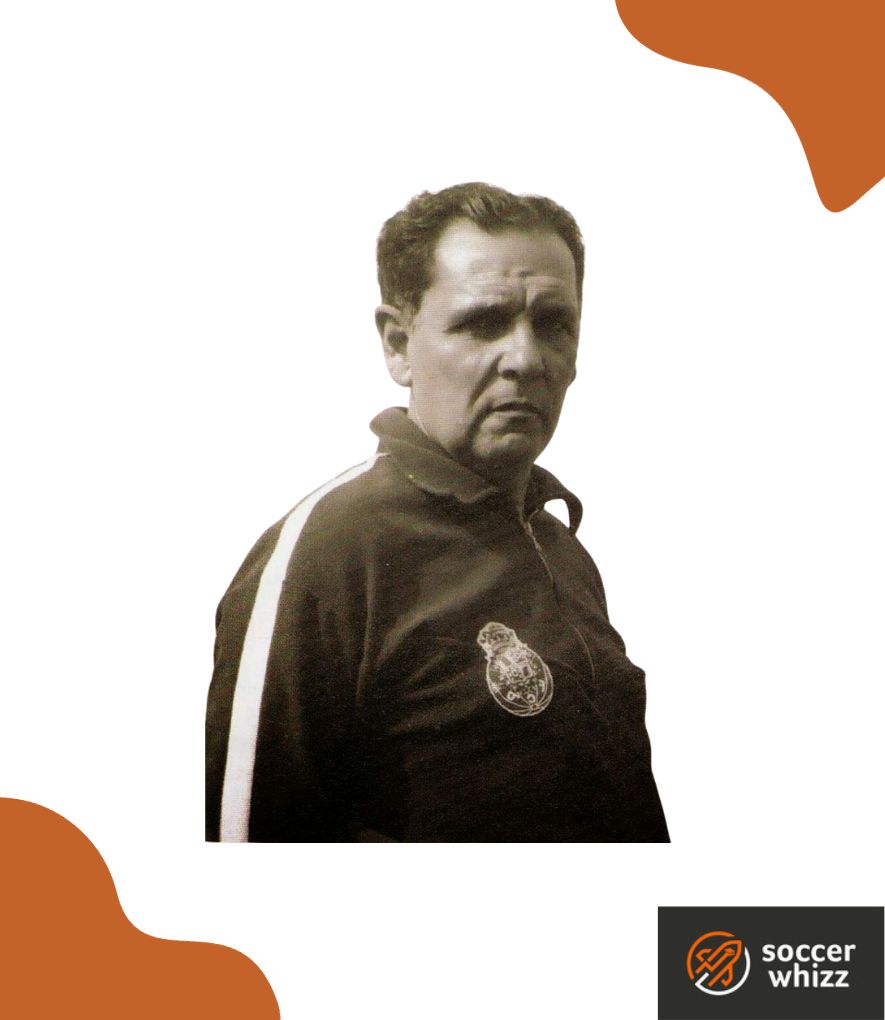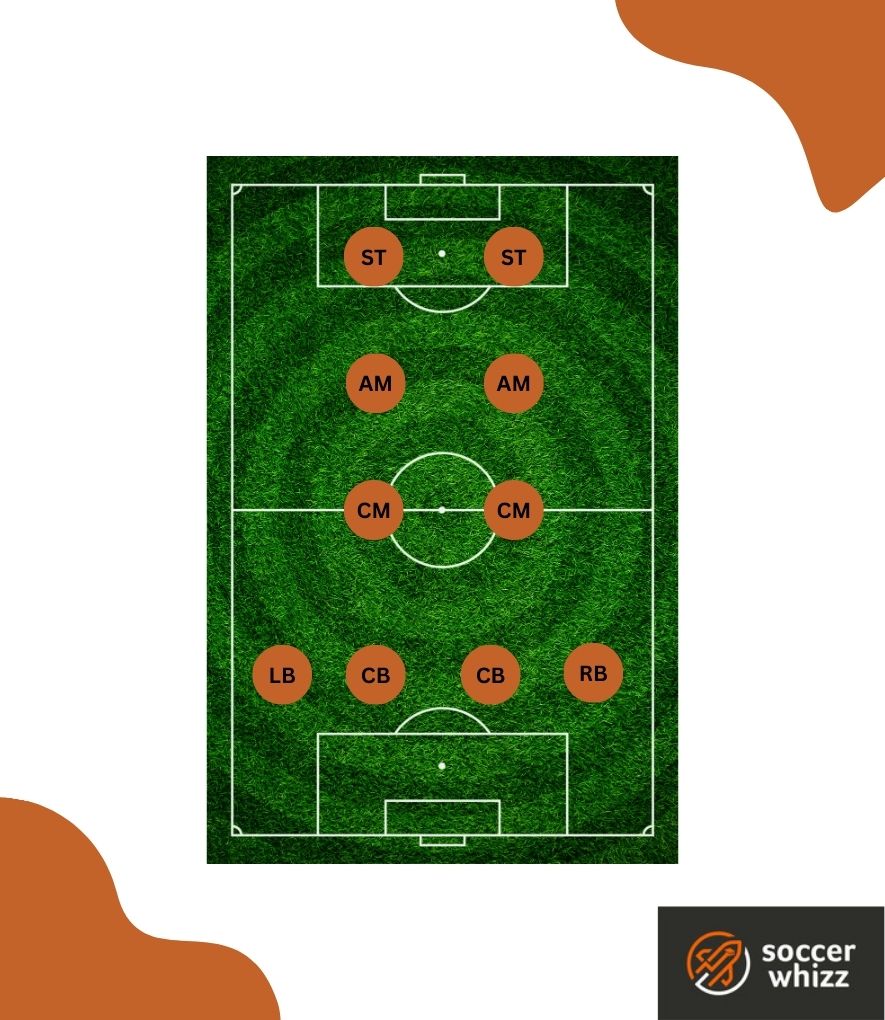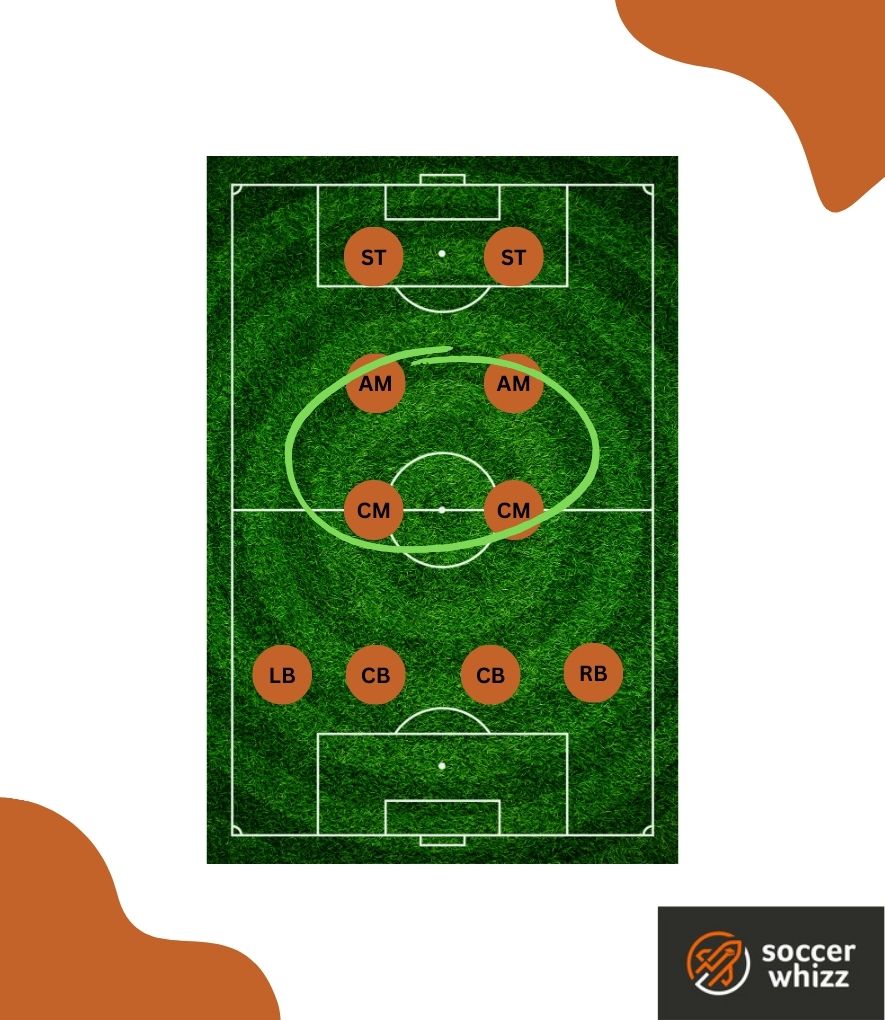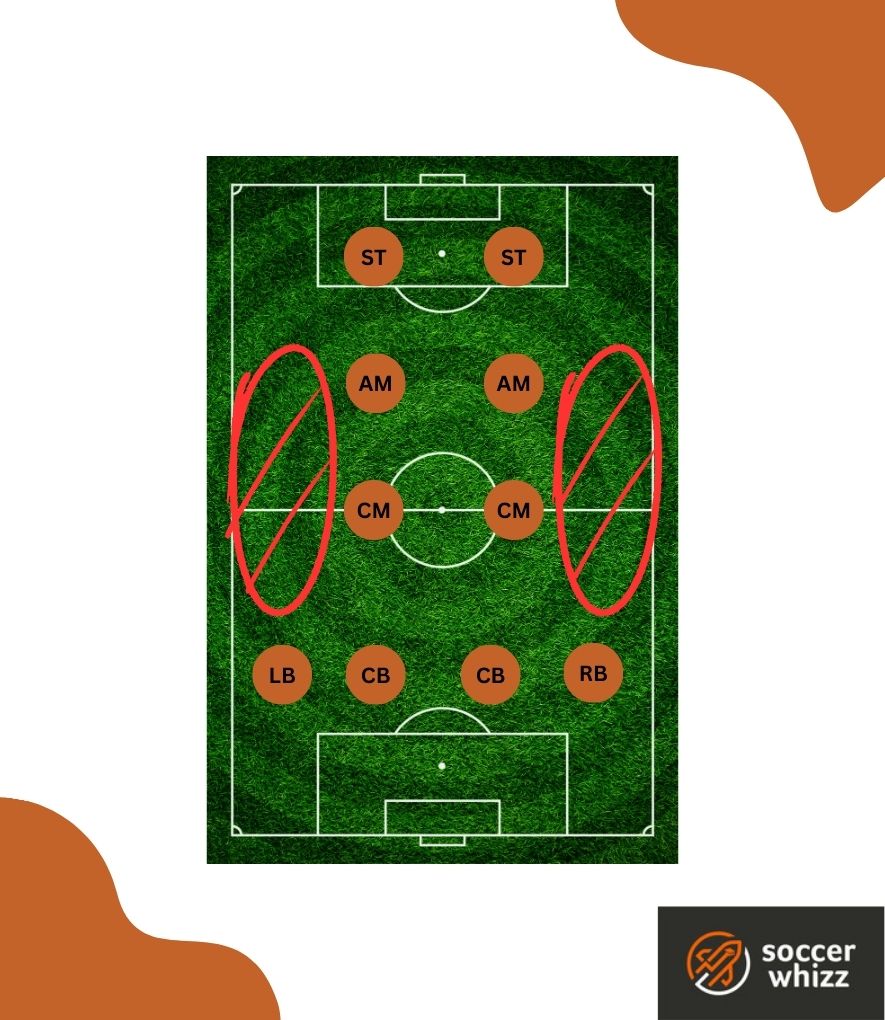In the intricate world of soccer tactics, coaches and teams constantly seek innovative formations to gain a competitive edge on the pitch.
Among the plethora of systems, the 4-2-2-2 formation emerges as an intriguing and dynamic tactical approach that redefines the principles of team structure and strategic play.
Balancing defensive stability with attacking versatility, the 4-2-2-2 formation has captivated soccer enthusiasts and strategists alike, captivating the imagination with its unique setup and potential for creating goal-scoring opportunities.
In this article, we embark on a comprehensive exploration of the 4-2-2-2 formation, unveiling its key principles, strategic advantages, and the roles and responsibilities it bestows upon players.
From its historical origins to its contemporary use in modern soccer, we delve deep into how this tactical setup has evolved and adapted to suit different teams’ playing styles.
- Where does the 4-2-2-2 shape originate from?
- How does a 4-2-2-2 formation work?
- What characteristics of the 4-2-2-2 lend itself well to being a "press friendly" shape?
- What are the benefits of a 4-2-2-2 formation?
- What are the downsides to employing this system?
- Which managers have used the 4-2-2-2 formation with great success?
- Closing thoughts
Where does the 4-2-2-2 shape originate from?
The 4-2-2-2 formation, often dubbed the “magic box,” “magic rectangle,” or “magic square,” has its origins traced back to 1950s Brazil under Flávio Costa’s tactical ingenuity.

Costa’s emphasis on free-flowing, improvisational attacking play laid the groundwork for this dynamic system.
Following suit, French manager Albert Batteux adopted the 4-2-2-2 structure, showcasing its effectiveness as he secured an impressive eight Ligue 1 titles – a record-breaking achievement unmatched by any other manager.

His success with Reims in the 1950s and Saint-Étienne in the 1960s further solidified the reputation of the 4-2-2-2 formation.
While prominently employed in South America, the 4-2-2-2 system found its way to Europe, with the France national side triumphing in Euro 1984 using this tactical approach.
The formation’s versatility and attacking potential have made it a favorite among managers seeking to orchestrate a dynamic and potent offensive force on the field.
How does a 4-2-2-2 formation work?
The 4-2-2-2 formation adheres to a traditional back four setup, comprising two central defenders, a right-back, and a left-back.
Positioned just ahead of this defensive line, a double pivot of two central defensive midfielders takes charge of safeguarding the defense and initiating possession build-up from the back.
The next section of the midfield consists of another duo, positioned wider and with a more offensive role.
Unlike central midfielders, these two attacking midfielders don’t usually operate wide enough to be considered wingers.
Instead, they adeptly navigate between the lines, offering support to the two central strikers and bridging the gap between the forward line and the midfield behind.
The focal point of the formation rests on the two center forwards, entrusted with seamless coordination, pressing the opposition’s defensive line, holding up the ball, and facilitating the involvement of attacking midfield teammates.

Together, this fluid and interconnected system forms the backbone of the 4-2-2-2, enabling teams to blend defensive solidity with potent attacking prowess on the field.
What characteristics of the 4-2-2-2 lend itself well to being a “press friendly” shape?
The 4-2-2-2 formation possesses several characteristics that make it particularly well-suited for a “press-friendly” shape, emphasizing a high-pressing style of play to disrupt opponents and regain possession effectively.
Compact midfield
The formation’s structure features a double pivot of two central defensive midfielders positioned just in front of the back four.
This compact midfield setup allows for coordinated and cohesive pressing, as the two central midfielders can quickly close down opponents and cut off passing lanes in the central areas of the pitch.
Balanced defensive cover
With four midfielders in the central zones, the 4-2-2-2 provides excellent coverage of the midfield.
This ensures that if the opposition bypasses the initial pressing line, there is still a second line of midfielders to put pressure on the ball carrier and force turnovers.
Dual striker setup
The presence of two center forwards in the formation can be instrumental in pressing from the front.
The strikers can lead the pressing efforts, putting pressure on the opposition’s defenders and goalkeeper, making it difficult for them to build up play from the back.
What are the benefits of a 4-2-2-2 formation?
The strategic setup of the 4-2-2-2 formation revolves around exploiting central overloads in critical areas, strategically positioning players around the opposition’s central midfielders to facilitate effective progression through the heart of the pitch.
This approach involves narrowing the midfield, reinforcing it with a double pivot, and ultimately dominating and overwhelming the midfield zone.

A key advantage of the 4-2-2-2 formation lies in the presence of two high-lying forwards throughout the game.
These strikers play a multifaceted role, not only linking play with midfield runners and creating space with their intelligent movement but also crucially finishing scoring opportunities.
Additionally, their responsibility extends to occupying the opposing center-backs, disrupting the opposition’s build-up play and deterring defenders from venturing into midfield to challenge for the ball.
Defensive solidity is maintained through the presence of two central defensive midfielders (CDMs) working in tandem with the center-backs (CBs).
This provides ample coverage and protection in central areas, enabling the full-backs in the 4-2-2-2 system to venture forward and contribute to the attack, offering valuable attacking width as they advance beyond the double pivot.
In offensive terms, the attacking midfielders, often referred to as number 10s, take on the role of primary creators.
Positioned between the lines, they forge the link between the defensive players behind them and the two forwards ahead.
Apart from their creative duties, they pose a goal threat themselves, pushing forward during counter-attacks and team movements to capitalize on second balls and unleash shots from distance.
Their versatility is evident as they skilfully move wide into crossing positions or make decoy runs to aid the full-backs in their attacking endeavors.
What are the downsides to employing this system?
The 4-2-2-2 system is notable for its lack of natural width in attack, presenting a prominent weakness in offensive play.
With no dedicated wingers and the midfield four split into relatively narrow units, the burden falls heavily on the full-backs to provide attacking width.
However, many wide defenders may not possess the ideal attributes for this role, hindering the team’s ability to launch effective counter-attacks out wide.

This lack of width also places additional demands on central players, forcing them to make extra movements to compensate.
For instance, when full-backs push forward, central defenders are required to cover wider areas since the midfield double pivot may struggle to arrive in time.
Consequently, this situation can lead to a detached or stretched defensive line, leaving the defense vulnerable to quick, direct counter-attacks.
While the 4-2-2-2 formation can be effective in mounting counter-attacks and threatening in transition, it may prove less useful for possession-based teams aiming to retain the ball for sustained periods.
In such situations, players can inadvertently obstruct each other, as they often find themselves on the same vertical passing lines, especially in central areas.
This particular drawback stands as the primary weakness of the 4-2-2-2 shape, limiting its suitability for teams seeking to maintain possession and exercise control over the game.
Which managers have used the 4-2-2-2 formation with great success?
Here are three names worth mentioning…
1. Manuel Pellegrini
Manuel Pellegrini, the esteemed Chilean manager, commands immense respect in the world of soccer.

Renowned for his unwavering belief in the 4-2-2-2 system, he has implemented this tactical formation with remarkable consistency and success at renowned clubs such as Real Madrid, Villarreal, Manchester City, and Real Betis.
Pellegrini’s tactical acumen is evident as he dynamically adapts the formation during matches, seamlessly transitioning from a 4-2-3-1 or a 4-4-2 shape based on the unfolding game situations.
2. Ralph Hasenhüttl
Ralph Hasenhüttl, the German coach, has gained recognition for his adept utilization of the 4-2-2-2 formation at teams like RB Leipzig and Southampton, showcasing its versatility both in attacking and defensive phases of play.

His direct and assertive approach to counter-pressing has been instrumental in his teams’ ability to win the ball in advanced areas and capitalize on the ensuing opportunities.
3. Ralf Rangnick
He is widely acknowledged for his exceptional understanding of football tactics and philosophy, particularly his use of the 4-2-2-2 formation at RB Leipzig.

Upon joining Manchester United, he swiftly implemented a highly effective rendition of the 4-2-2-2 formation, which worked to moderate success in a couple of fixtures.
Closing thoughts
In conclusion, the 4-2-2-2 soccer formation stands as a captivating and dynamic tactical system that has left an indelible mark on the beautiful game.
Throughout this exploration, we have delved into the formation’s key principles, advantages, and challenges, shedding light on its versatility and potential to transform teams’ playing styles.
The 4-2-2-2 formation has proven its worth, leaving an enduring legacy in the hands of innovative coaches and teams who embrace its tactical brilliance.
As the game of soccer continues to evolve, the 4-2-2-2 formation remains an inspiring and influential choice, captivating both fans and strategists alike with its ability to balance defensive solidity with attacking flair.
Should you wish to read more about similar tactical shapes, then check out our in-depth article on the 4-4-2 soccer formation as well as our comprehensive coverage of the 4-2-4 formation.
If you enjoy the content that I create and would like to buy me a coffee, then I’d really appreciate it!
Any money that I earn through this donation will be re-invested into more content for this website.
Additionally, by sending in a donation you’ll also receive a copy of my recently released 190+ page eBook on Soccer Ball Care, as well as be subscribed to our mailing list where you’ll be regularly informed on the latest developments concerning the Soccer Whizz blog.
- Future Icons: Europe’s Emerging Midfield Maestros Set for Glory - December 4, 2023
- Kickstarting a Revolution: How Soccer Transformed the United States Over the Last Four Years - October 7, 2023
- 4-1-4-1 Soccer Formation [Analysis] - September 23, 2023

